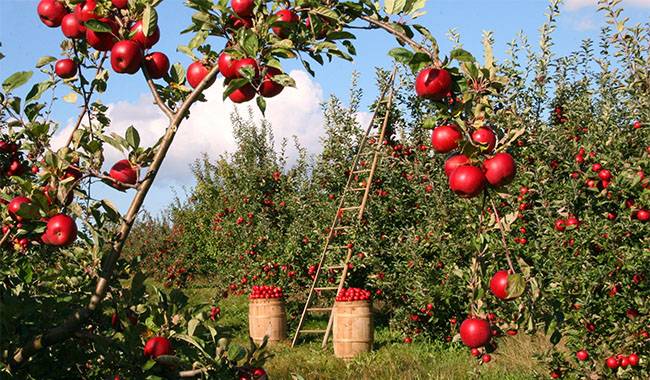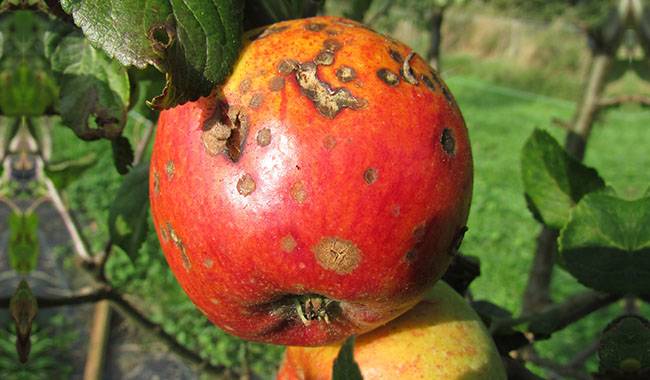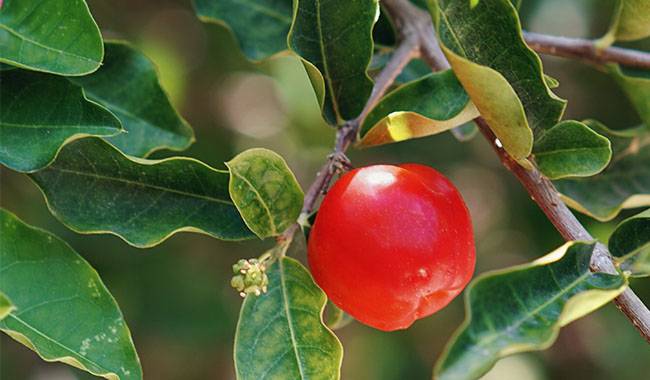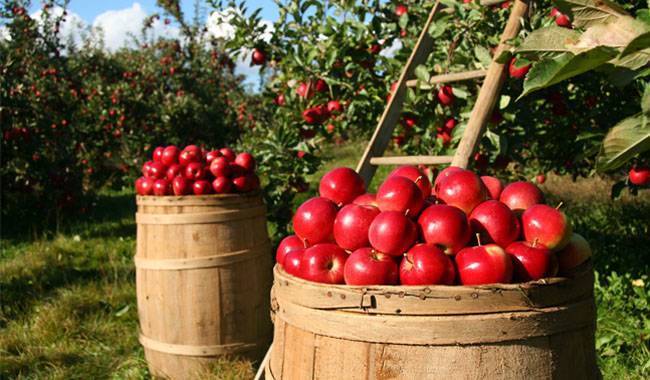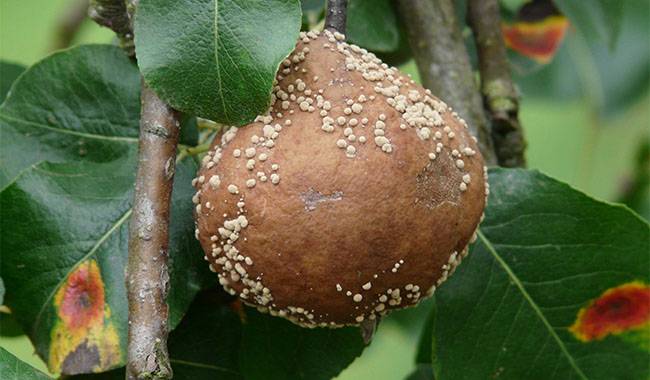
Apple trees in bloom – what a miracle. There really is no better color when apple trees are in bloom, and it’s heartbreaking when the orchard is literally abandoned in the summer. Disease-affected fruit rots under the trees. In years with epiphytic tree infestations, up to 90% of the crop dies.
Apple trees, like other orchard crops, are affected by 3 types of diseases: fungal, bacterial, and viral. In addition, each year, more and more orchard trees are affected by agricultural practices such as the use of fertilizers, water and temperature control, and the use of protection against pests and diseases. The enemy must be recognized by sight – only then can the battle for the harvest be won without harming the health of families and animals. A common enemy of gardening is the failure to maintain crops in an appropriate manner. This article allows you to learn what fungal and viral diseases of apple trees are and how to prevent and control them.
GENERAL AGRONOMIC MEASURES TO CARE FOR GARDEN CROPS
Placing the garden in fallow or fallow ground. Systematically eliminate weeds where pests and diseases gather.
Remove fallen leaves, fruits, and other debris from the vicinity of the garden every year during the growing season and in autumn. Diseased fruit is destroyed. Leaves from healthy trees are often placed in compost pits or used for mulching.
Apple trees are infected with the rust disease of common prickly cypress. Therefore, juniper trees should not be planted near orchards.
In the fall, after leaf drop, systematically inspect the trunk and trellis branches. Prune the canopy and remove diseased, dry, inward-growing branches. Clean off old bark shed from trunks and scaffold branches.
Ensure that holes, cracks, and crevices are sealed with special preparation. Thick cuts should be repainted or other protective substances.
Prune from February to March, when the plant is at rest (no sap flow).
Several times a year (not only in spring and autumn), but the trunk and scaffold branches are also painted white with a freshly prepared lime solution mixed with clay, copper sulfate, glue, fungicides, and fungicides.
In the fall, a phosphorus and potassium fertilizer is applied, and the soil is disinfected with copper sulfate, ammonium nitrate, and biological preparations before digging. If the garden is already sodded (no re-tillage required), drill 5-10 holes along the edge of the canopy, fill with the fertilizer mixture, cover with sod and water.
During the growing season, feed apple trees in the spring with ammonium nitrophosphate at 50-100 g per crown. Fertilize annually with micronutrients.
Irrigate at least twice in the summer (especially in dry times). After watering, cover the soil with mulch for shallow cultivation.
CONTROL OF FUNGAL DISEASES
Apple trees are infested with a disease-causing fungus. The fungus and its spores overwinter in fallen leaves, diseased fruits, cracks, and depressions. The overwintered spores, part of the fungus, begin to actively proliferate in warm spring weather, taking over healthy parts of the asexual and generative organs of the plant. The most common and harmful fungal diseases are fruit rot, powdery mildew, black rot, and other rot diseases, scab, rust, brown spot Cytospora.
Disease symptoms
Each type of fungus has its own unique signs and characteristics that can be unified by the manifestation of external symptoms. Fungal infections manifest themselves as individual oil-like translucent or rounded red and yellowish dry spots, grayish-white patches, various velvety touches, and circles formed on the leaves. They turn yellow, curl, and stop growing. Individual round spots appear on the fruit and proliferate. Fruit tissues begin to rot or become lignified and dehiscent. Fruits are mummified on the branches and then fall off. The most favorable conditions for the spread of fungal diseases are warm, humid weather.
You always want to grow healthy organic crops at home, so some gardeners think it’s best not to use any preparations at all. But this is fundamentally wrong because, after a few years, there will be nothing left in the garden except wilted or completely diseased plants. Protective measures in the garden are a must. Biological preparations made on a natural basis – beneficial microflora destroying disease-causing fungi – are now used in garden treatments. These preparations are completely harmless and can be used the day before harvest.
Protection techniques using biological agents
In autumn, on the bare canopy of apple trees, and in spring, before waking up from winter rest, blue spray with a 2-3% solution of copper sulfate.
In spring, before germination, disinfect the soil with a 7% solution of urea or a 10% solution of ammonium nitrate. Thoroughly spray the soil in the root zone and dig at 4-6 inches (10-15 cm) after 2-3 days.
At the pink bud stage and every 7-10 days thereafter, treat apple trees with a biological preparation “Xylophilus spp.”, “Phytosporin,” as recommended. They can be used to treat the garden until harvest, and the use of biological agents containing fluorescent pseudomonas “Pseudomonas fluorescens” helps to prolong the shelf life of the product. In order not to cause dependence of negative microflora on the preparation, it is necessary to constantly change biological preparations when treating plants.
Remember! Biological agents do not alleviate the disease with a single treatment. Systematic treatment of trees is necessary. Maximum effect can be achieved in the second or third year.
Chemical measures to protect apple trees from fungal diseases
Insect infestations in orchards are sometimes so severe that biological agents do not have any effective effect on infected trees. In such cases, chemical protection measures can be applied.
When using chemical agents, it is important to observe health precautions (protective clothing, gloves, goggles, helmet). After work, wash your face and hands with soap and water or take a shower.
Technical measures
Protective measures start in autumn. After removing weeds, leaves, and fruits, spray apple trees blue with a 3% solution of copper sulfate.
In spring, before the buds open, the blue spraying can be repeated, treating the crown, or using a 1% DNOC solution.
As a preventive measure, instead of copper sulfate and DNOC, the soil in the crown, stem, and root zone can be sprayed with a mineral fertilizer solution. Carefully treat the crown with a 5% solution of urea and the soil with a 7% solution. A 10% solution of ammonium nitrate or a 15% solution of ammonium sulfate can be used to treat the trunk and branches. After a few days, the treated soil should be turned over to a depth of 4-6 inches (10-15 cm).
During the green cone stage of leaf buds, before and after flowering, treat the canopy with Bordeaux mixture at 1%. Bordeaux mixture is effective in protecting trees from scab, moniliasis, powdery mildew, and other fungal diseases. It is not toxic, so it is allowed to treat trees with its solution after flowering.
Starting from the rosebud stage, apple trees are treated with a plant growth regulator every 2-3 weeks according to the instructions. Spraying was stopped during flowering. The last treatment is applied one month before harvest or at the fruit setting stage.
To reduce the burden of the number of treatments, you can instead treat the trees with a mixed tank in the protection system, checking the compatibility of the preparations beforehand.
VIRAL DISEASES AND BEST PROTECTION TECHNIQUES
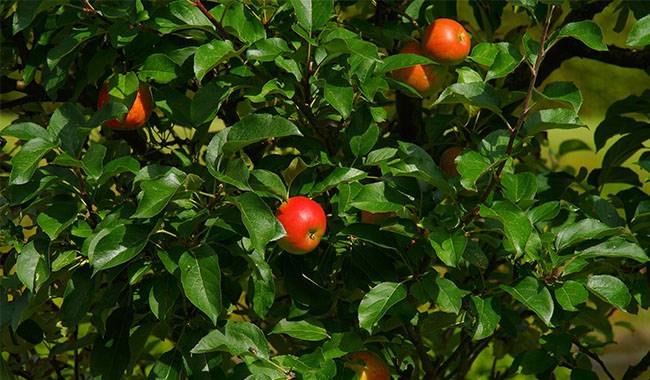
Viruses are tiny protein particles that are invisible with an ordinary microscope, but harmful enough for living plants. They are spread by pests through open plant tissue (grafting), water, and wind.
External symptoms of the disease
At the beginning of the introduction of the virus, its destructive work is not obvious, and the plant continues to function as a healthy plant. The appearance of the disease resembles a fungal infestation. Spots appear on the leaves, and the fruits are deformed. As time passes, these differences become more pronounced. Individual spots on the leaves merge into a mosaic pattern of greenish-yellow colors and tones. The leaf layer becomes necrotic, and the affected leaves fall off. Flattening and flattening of the shoots and softening of the wood can be observed. Branches become unusually soft and rough and break easily under the heavy pressure of the crop. Individual flowers and inflorescences become severely deformed and take on an ugly shape. During spring development, a bunch of dwarf shoots with leaves or only leaves of unusual shape and color is formed at the end of young shoots. A bunch of greasy shoots (witch’s ring) is formed on the older branches. Fruits crack, form crusty spots and excrescences, lose their flavor, and also fall off.
The external manifestations of viral diseases determine their names. The most common viral diseases of apple trees are mosaic, starry split fruit, panicle (witch’s broom), rosette, hyperplasia, or epiphytotic of asexual and reproductive organs (ugly), green ring spot, and wood pockmark.
There are no preparations to eliminate the source of infection of this virus. Therefore, the main control measures are agricultural farming techniques.
Agronomic measures are the same as those used to control fungal diseases. Special attention should be paid to the following measures.
Pruning is carried out only when the plants are in deep dormancy (February).
When pruning, all diseased parts of the plant and the whole tree should be removed. Do not use the waste material for composting.
If rosette and panicle disease, the most common diseases on apple trees, are evident, use reduced doses of simple forms of phosphorus and nitrogen fertilizers. Switch to complex forms of fertilizers in which the elements are in optimal proportions for the cultivated crop.
Introduce micronutrients, including zinc sulfate, in dressings, especially if there is evidence of rosette formation.
Spraying with phytohormones to improve the immunity of plants to viruses. These agents are effective as a preventive measure. However, they do not stop the development of the disease.
Note! The main defense against viral diseases is the suppression of sucking pests that are the main carriers of viruses.
SYMPTOMS OF BACTERIAL INFECTIONS
The most common bacterial infections are bacterial scald, bacterial root rot, bacterial necrosis, and bacterial spot disease.
Typical symptoms of a bacterial attack on the above-ground organs of apple trees are as follows.
In bacterial rot or bacterial necrosis, blisters appear on young shoots, which open up and expose the internal tissues of the plant. Leaves are covered with brown spots. Generally, the affected organs of the plant are indented and range in color from pinkish-brown with a purple border.
In bacterial scorch disease, affected branches look like they have been scorched by fire. The manifestations of the disease begin in early spring (bud bloom) when the generative and vegetative organs turn brown and black and stop growing and developing. Trees can die suddenly or become covered with blisters of varying sizes filled with bacterial slime. It oozes from wounds, ovaries, cracks in the bark, and ruptured blisters. It covers the affected organs with a gray film or solidifies into milky droplets. The multiplying bacteria migrate from seedlings to larger plant organs through blood vessels, causing the death of the entire plant.
In bacterial root rot, the disease appears first on the root neck and then on the trunk and branches, showing smooth growth that turns explosively brown or black over time. These bacteria penetrate the tissues and flourish through wounds, cracks, cuts, and insect damage to the integrity of the bark. They cause increased division of tissue cells, which leads to overgrowth and the formation of swellings. Inflorescences decay over time, and bacteria transfer to healthy tissues in above- and below-ground organs, including the roots. Growth occurs at the roots, and the swelling becomes hard. Above- and below-ground organs do not function properly, and the tree dies.
REMEDIES AGAINST BACTERIAL WILT
As with other diseases, the basic remedy is good orchard management. In order to keep it “healthy,” not only must all procedures be carried out in a timely manner, but measures must be taken to prevent pathogens from entering the garden. To do this, you must.
- plant with planting material of absolutely healthy zoned varieties, preferably from a specialized nursery.
- always disinfect working tools, especially during grafting, pruning, and other procedures that destroy the integrity of the plant’s outer skin.
- If treatment with preparations is ineffective, trees must be destroyed outside the garden and locations within the garden thoroughly disinfected with fungicides, mineral fertilizer solutions, copper or iron sulfate.
Copper-containing products, such as Bordeaux mixture, copper sulfate, and copper chloride, have a negative effect on bacterial microorganisms. Use them to control fungal diseases and also to protect apple trees from bacterial diseases.
Many biologics-fungicides with targeted action have been produced and are effective: Cooper Fungicides, Lime Sulfur Fungicides, Oil Fungicides, Captan. But the biologics developed on the market are based on sporulating fungi. These preparations are absolutely harmless to family members, animals, and beneficial insects. Specifications, methods, and timing of the preparations are described in detail in the accompanying documents and recommendations for use for specific diseases and specific crops.
FALL AND WINTER PEST CONTROL OF APPLE TREES
The protection of apple trees from pests can be reasonably divided as follows
- Autumn and winter seasons.
- Spring and summer season.
Many pests overwinter in the soil. Some hide in fallen leaves and weeds. Therefore, the soil under apple trees should be cleared of weeds, fallen leaves, and mummified fruits. Apply phosphorus and potassium fertilizer and turn over 4-8 inches (10-20 cm) of soil to avoid damaging the tree’s root system.
In winter, the main active pests are mice, hares, and bright sunlight.
- To avoid trunk burns in winter (especially in young apple trees), bleaching can be done with a solution of fresh cooked lime and clay. Copper sulfate and glue are added to the mixture to obtain better adhesion. Any insecticide and fungicide for pests and diseases can also be added.
- Trap tapes were attached to old trees at the height of 12-16 inches (30-40 cm) and secured to the trunk with a special caterpillar glue that does not dry out over time. It is applied to trunks and trellis branches 12-16 inches (30-40 cm) high in March and April. Waking pests adhere to the glue and are killed, including ants.
- In the south, young apple trees were protected from winter and spring temperature fluctuations that could cause young bark to crack. In the central and northern regions, trunks were insulated with roofing felt or burlap and other materials. Young seedlings were covered by covering the trunk and scaffolding branches (sometimes to the top).
- Rats increase their pest activity during the winter. They damage the root system and gnaw on young bark. The wounds become infected, and the trees become sick and gradually die. Starting from autumn, mice should be poisoned. The poisonous bait is made from a mixture of any grain and sunflower seeds. The mixture is mixed with 50-70 grams of sunflower oil (which enhances stickiness), 70-100 grams of rat poison or other poisoning agents, mixed thoroughly, spread near the burrow or within 10-13 feet (3-4 meters) of the plot. The poisoned grains must be covered with unnecessarily thick plastic, iron, or wooden boards (so that they will not be blown away by the wind) to protect them from birds.
- In winter, after the next snowfall, the snow should be tamped down around the planting circle. This will reduce the chances of mice coming into contact with the garden crops.
- In recent years, rabbits have proliferated and are very harmful in winter, especially to young trees. They can easily overcome the insulating cladding and gnaw on the tender bark. Prevent rabbits – Rabbits’ chain-link nets, placed over the insulation, are about 40 inches (1 m) high. The net should be buried in the ground below.
Every garden should have bird feeders and nests that attract birds. They are of great help in eliminating pests in spring and summer.
SPRING AND SUMMER PEST CONTROL FOR APPLE TREES
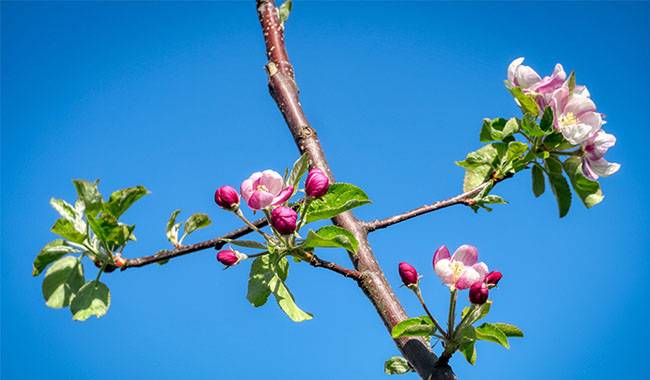
Spring is the peak season for orchard work. In a concise period of time, a lot of work must be done on the garden and prepare it for the growing season.
A. General and preventive measures
- Check apple trees again. We remove overwintering nests of pests, clean loose bark from trunks, repair holes and cracks in the bark, and bleach or paint jagged trunks.
- With the arrival of steady warm weather, remove insulation, treat used material with insecticidal and disease-killing preparations, and store indoors until fall.
- Remove trap strips and burn them. To protect the trunks of perennial trees, skeletal branches, and stumps of young apple trees from the burning spring sun, repeat whitewashing, adding to the basic mixture the insecticide Dichlorvos and others that attract pests. For whitewashing young apple trees, it is better to use chalk, water emulsion, or other materials that do not cause burning of young bark, rather than lime. Nitrofen can be added to the whitewash mixture at a rate of 200 grams per bucket of water. This product is effective against overwintering pest eggs. The same solution can be used on apple trees before the buds open.
- After whitewashing, apply a special anti caterpillar glue, treat with insecticide and then put on new trap tape. Ants and other pests will die on the trap tape and sticky tracks. 10-12 days later, replace the trap tape again in the spring. Always burn the used ones.
- As warmth approaches, spread film patches under the still leafless canopy and shake the branches with a long pole. At 42-48 °F (6-9ºC), weevils and serrated weevils numbed by the cold will fall to the litter. It remains to collect and destroy the pests. Once you do this, you can significantly reduce the number of pests in your garden.
TYPES OF PESTS ON APPLE TREES
Pests are divided into 2 groups based on the way they harm plants: sucking and biting.
Sucking pests are those that settle on the plant, sucking the sap through perforations and depriving the culture of normal nutrition (aphids, mites, scales, leafhoppers, stoneflies).
Gnawing pests feed on leaves buds, buds, flowers, young shoots, and roots. They eat young plants and reproductive organs, causing irreparable damage to plants. This group includes caterpillars of various butterflies, long-horned beetles, click beetles, moustache beetles, may beetle, and others.
Sucking pests (aphids, leaf beetles, broom beetles) actively reproduce from early spring, forming large colonies that cover young shoots, green shoots, and flowering leaves in several layers during epiphytotic. The colony excretes “honeydew” during its activities. Sweet liquid is a favorite food for ants and a good breeding ground for fungus. Ants are unwitting carriers of many fungal diseases when they feed on honeydew.
Aphids and fleas join the larvae of mites that drool and comma from their eggs before and during flowering after the apple trees have flowered profusely. They spread on the shoots of the canopy and feed on the sap of the plant. As a result, young seedlings may die, and on adult fruit crops, some perennial branches will shrivel.
CONTROL MEASURES FOR SUCKING PESTS OF APPLE TREES
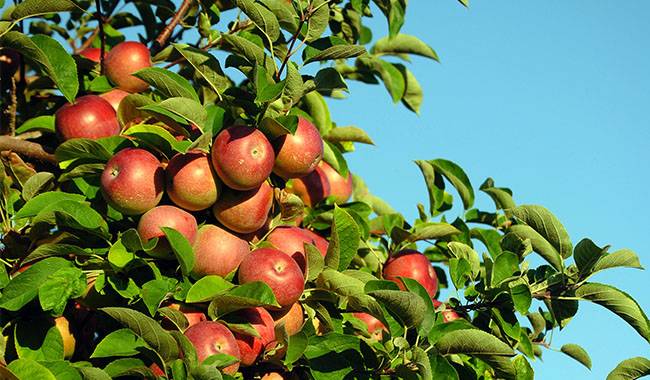
Methods of controlling sucking pests are divided into agricultural techniques (discussed in the above article), chemical and folk methods. Finding specific products for each pest is not cost-effective and is unnecessarily cumbersome. Chemicals with systemic action are best suited for them. Accumulating in the tissues of crops, they enter the intestines of pests along with toxic plant sap, causing their death.
Chemical application systems for sucking pests
Chemicals must be applied safely. Chemicals must be applied according to recommendations and instructions. It is very important to observe the expiration date of edible fruits. Always wear protective clothing and, in calm weather, preferably a gas mask. After finishing work, change your clothes and take a shower.
- Spray the trunk and crown of apple trees with nitrocellulose before the buds open. Prepare a solution with 200 grams of the product per bucket of water. Nitrosulfuron destroys pest eggs deposited in the asexual organs of the plant since autumn.
- Spraying with a solution of Dinitro-ortho-cresol (DNOC) at a concentration of 100 g per 2.5 Gal (10 l) of water before germination is also effective.
- During the bud swelling stage, before and after flowering, it is best to spray with a tank mixture of HOM and organophosphorus malathion, as recommended in the Annex.
- Among the systemic preparations for destroying the gastrointestinal tract of sucking pests, the most effective for all types of aphids, leaf beetles, comma moths, pseudomoths are Rovicurt, etc.
New formulations have been released that act selectively both on the entire group of sucking pests and on them.
- Sunmite is recommended to control mites and whiteflies in all stages of apple tree development.
- Borneo fungicide kills not only the larvae but also the eggs of the pest. It can replace nifedipine in the treatment of trees.
- Stirrup M works specifically against spider mites.
- Actara, confidor are effective against aphids. 5.
- Mospilan and Prestige are systemic and contact agents that kill eggs, larvae, and adults of pests.
Use of biological agents to control sucking pests
Biological agents (bioinsecticides) are a better way to protect apple trees from pests in your home. They are harmless to family members, pets, and beneficial insects (bees). They can be used practically until the end of the growing season, including the harvest season.
Biopesticides are based on live cultures of beneficial microorganisms that destroy pests by occupying their organisms during their life activities.
The most effective biopesticides used for plant treatment are BITOXYBACILLIN, LEPIDOCIDE. The dosage and duration of treatment of each product are specified in the accompanying recommendations and instructions. It should be noted that biopesticides can be easily combined with other biological agents, which reduces the burden on trees during treatment.
- Aphids and whiteflies can be effectively eliminated by Verticillium.
- BITOXYBACILLIN rapidly attacks aphids and spider mites.
Biological insecticides have systemic and contact action. They cause the death of sucking pests and, at the same time, have neurotoxin-type properties that lead to paralysis and the death of adults. Biopesticides have a short duration of action on pests and need to be used more frequently. However, health is more important!
GNAWING PESTS ON APPLE TREES
Unlike sucking pests, nibbling pests feed on plants and reproductive organs and cause physical damage to apple trees. This group includes bud beetles, flower beetles, leaf beetles, weevils, beetles, and moustache beetles. Fruit woodpeckers specialize in destroying fruit, while numerous butterflies are the main producers of caterpillars capable of destroying crops in a short period of time. Most pests overwinter as adults in the waste products of crops (dead fruit, fallen leaves, pruned parts of branches, bark, etc.) or lay eggs, and with the arrival of spring and warmth, the larvae and caterpillars parasitized on plant organs hatch.
Control measures for biting pests
Chemical products
The same chemical agents as the sucking representatives are used to prevent biting pests – carbosulfuron, benzophosphate, Actara, Decis, Fastac.
Dichlorvos is especially recommended for sawdust flies and micro-moths. Together with other preparations, ZOLONE can be effective against fruit moths.
Biological agents
Biological insecticide FITOVERM is the leading biological agent. By selective action on pests, Actofit is successfully used against nematodes, caterpillars in the early stages of development, and mites.
Warning!
All chemicals have a high risk for human health.
New agents can be used in tank mixtures (compatibility testing required).
Most biological agents can be used after treatment with chemical insecticides.
The use of chemical products is limited in time. The last treatment should be applied no later than one month before the fruit set or one month before harvest.
In conclusion, it should be noted that in the vast majority of cases, the same insecticides, both chemical and biological, are used to control sucking and biting pests. It is pretty rare for apple trees to be affected by only one pest, so by applying a product that targets one pest, you are actually protecting the apple tree from other pests as well. The main prerequisite for effective protection is that the instructions and recommendations for their application must be followed precisely.
More Related Information About Planting & Growing apple trees




